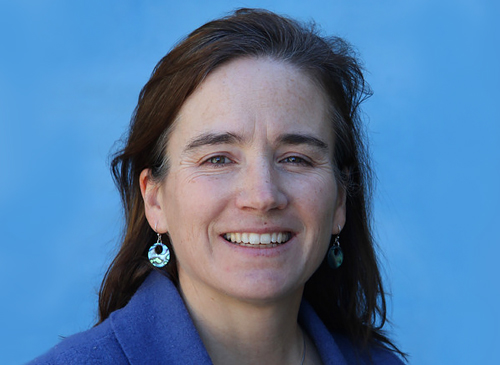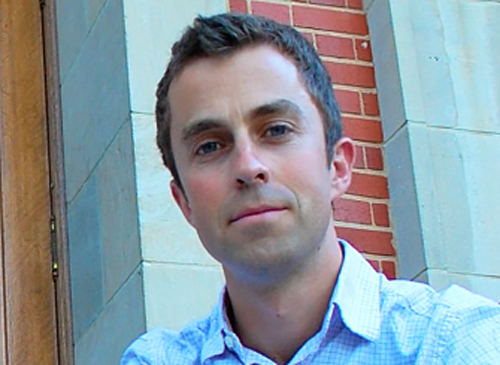Cecilia Bitz is an atmospheric scientist who studies the role that sea ice plays in shaping the climate in high latitudes. She is interested not only in our present and future climates, but also climates of the past. She is actively engaged in research on improving prediction of Arctic sea ice and sea ice data assimilation, investigating wave-ice and coupled air-sea-ice interactions that control large-scale climate. She is the director of the UW Program Climate Change and leads several projects funded by the National Science Foundation and the National Oceanographic and Atmospheric Administration. Bitz has been called to testify to the U.S. Senate on Arctic climate change.
Polar Climates

Cecilia Bitz

Alex Gardner
Dr. Alex S. Gardner is a Research Scientist in the Sea Level And Ice Group, in the Earth Sciences Section. He studies the Earth’s cryosphere (frozen Earth) with a particular focus on glaciers and ice sheets and their impacts on sea level rise and water resources. He is interested in how glaciers respond to natural and human induced forcing as well as how changes in their energy balance modify the Earth’s climate. Alex is a member of NASA’s ICESat-2 Science Definition Team and NASA Sea Level Change Team.
Marika Holland
Dr. Marika M. Holland is a Senior Scientist in the Paleo and Polar Climate Section of the Climate and Global Dynamics Laboratory at NCAR. Her research interests are related to the role of sea ice in the climate system, including ice/ocean/atmosphere feedback mechanisms, high latitude climate variability, and abrupt climate change. She is also interested in coupled climate modeling and the improvement of sea ice models for climate simulations and has contributed to sea ice model developments for the Community Earth System Model (CESM). Marika has served as the Chief Scientist of the CESM project and as co-chair of the CESM Polar Climate Working Group.
Eric Larour
Eric is the project lead for the Ice Sheet System Model (ISSM), a state-of-the art-ice flow modeling software developed at JPL in collaboration with University of California Irvine. Its main goal is to model the evolution of the mass balance of polar ice caps (Antarctica and Greenland) projected into the near future (10-100 years), and to understand its contribution to local sea-level rise around the world. Eric’s research interests include data assimilation of remote sensing observations into projections of ice sheet mass balance and sea level rise; forward modeling of polar ice caps using large-scale, high-resolution, multi-physics, multi-model based finite element ice flow models; and development of high-performance parallelized computer architectures for modeling Cryosphere and Sea-Level processes.
Paul Kushner
Paul Kushner studies various aspects of atmospheric dynamics, atmospheric circulation, and climate change. He is also a principal investigator of the Canadian Sea Ice and Snow Evolution Network (CanSISE, www.cansise.ca), a research network studying snow, sea ice and related climate processes in the Arctic and the Western Cordillera region of Canada. Previously, he was a leader of GFDL’s Global Atmospheric Model Development Team. During his 2018-2019 sabbatical, he is visiting the Paul G. Allen Philanthropies (Vulcan Inc) to assist with their climate model initiative, as well as carrying out research at the University of Washington, Lamont Doherty Earth Observatory (Columbia University) and the University of Bergen.

Tapio Schneider
Tapio Schneider studies atmospheric turbulence and its influence on the global climate, both on large scales (weather systems) and smaller scales (clouds). He develops theories of turbulence with the help of simulations and observations and uses them to understand and model climate changes and feedbacks that occurred over Earth’s history and that are likely to occur in the future. He also uses insights about fundamental aspects of atmospheric dynamics to understand phenomena on other planets, for example, the formation of jets on the giant planets.
Helene Seroussi
Dr. Helene Seroussi is a Scientist at Caltech’s Jet Propulsion Laboratory in the Sea Level and Ice Group. Her research interests are focused on better understanding and explaining ongoing changes in the cryosphere, as well as reducing uncertainties in the ice sheet contribution to sea level rise using numerical modeling. She is interested in understanding the interactions of ice and climate by combining process studies, state-of-the-art numerical modeling with remote sensing and in situ data. She graduated from École Centrale Paris (France) in 2008 and received her PhD in 2011 in ice sheet systems numerical modeling and data assimilation from the same university. She Is a member of the scientific committee of ISMIP6 and co-chair of the MISOMIP project.
Mark Simons
Dr. Mark Simons is Chief Scientist for NASA’s Jet Propulsion Laboratory. In this role, he is responsible for leadership of the scientific and research community at JPL, and serves as the focal point for interactions with universities and the external research community. Dr. Simons is a Professor of Geophysics in the Seismological Laboratory within the Division of Geological and Planetary Sciences at Caltech. In collaboration with JPL, Mark currently serves as Caltech’s Co-Principal Scientist for the Advanced Rapid Imaging and Analysis (ARIA) Project and is the solid earth science co-lead for the NISAR science definition team.
Andrew Thompson
Andrew Thompson’s research focuses on the physics of the ocean’s circulation and its impact on global climate. He uses a combination of approaches to make progress on understanding ocean dynamics and how they contribute to previous and future climate transitions. These approaches include simple analytical and process models to explore the sensitivity of the circulation to a wide range of conditions, more realistic ocean general circulation models and sea-going observations using autonomous ocean gliders.
